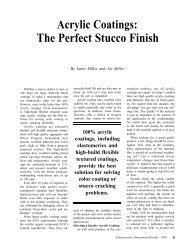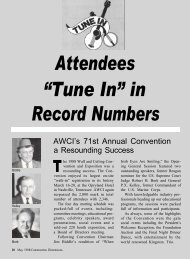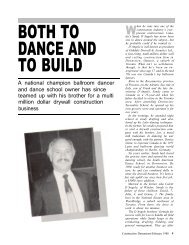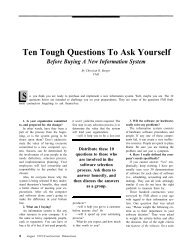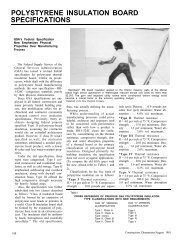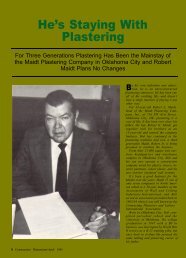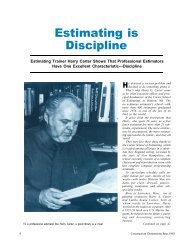The Basics of Patent Law - AWCI
The Basics of Patent Law - AWCI
The Basics of Patent Law - AWCI
You also want an ePaper? Increase the reach of your titles
YUMPU automatically turns print PDFs into web optimized ePapers that Google loves.
<strong>The</strong> <strong>Basics</strong> <strong>of</strong><br />
ou have invented something that you<br />
think could make you rich. <strong>The</strong> word<br />
“patent” comes to mind. Should you get<br />
one? Can you get one? How do you get<br />
one? While the answers to these questions<br />
can be complicated, the following general<br />
overview may assist you in deciding whether<br />
to pursue your dream with the United States<br />
<strong>Patent</strong> and Trademark Office.<br />
A patent is a grant issued by the U.S. government to an inventor.<br />
It gives the inventor the right to exclude others from using,<br />
making or selling an invention for a period <strong>of</strong> 17 years. (<strong>Patent</strong>s<br />
for plants and for design—i.e., appearance only—are issued for<br />
a shorter period <strong>of</strong> time.) In short, a patent gives an inventor<br />
the right to sue others to protect his interest in his invention; it<br />
is not a guarantee <strong>of</strong> financial rewards. After obtaining a<br />
patent, it is up to the inventor to exploit his invention for<br />
financial gain and to take steps to keep others from doing so<br />
without his permission.<br />
<strong>The</strong> right granted by a patent is considered to be the inventor’s<br />
intangible personal property An inventor, therefore, can sell,<br />
mortgage, license or will his patent to his heirs.<br />
What Inventions Can Be <strong>Patent</strong>ed?<br />
position <strong>of</strong> matter, or any new and useful improvement<br />
there<strong>of</strong>, ...”<br />
<strong>The</strong> word “process” refers to a method for doing something.<br />
<strong>The</strong> phrase “composition <strong>of</strong> matter” refers to the chemicals or<br />
ingredients that make up something. <strong>The</strong> United States Su-<br />
Anything under the sun made by<br />
man is potentially patentable.<br />
To qualify for a patent, an<br />
invention must be new, useful<br />
and nonobvious.<br />
preme Court has interpreted this statutory description <strong>of</strong> patentable<br />
subject matter broadly, holding that it includes “anything<br />
under the sun that is made by man.”<br />
What is excluded under this definition? Material in its natural<br />
state (e.g., oxygen); principles or laws <strong>of</strong> nature or scientific<br />
truths (e.g., gravity); mathematical expressions <strong>of</strong> scientific<br />
truths (e.g., calculation for the volume <strong>of</strong> a square); and phys-<br />
<strong>Patent</strong> protection is given to “[w]hoever invents or discovers<br />
any new and useful process, machine, manufacturer, or com-<br />
40 Construction Dimensions r November 1996
ical phenomena (e.g., lightning) are not patentable. Put<br />
another way, patents are given for what did not exist before<br />
and not for bringing to light what existed but was not known.<br />
Also, ideas in themselves are not patentable. What is patentable<br />
is the physical exploitation or concrete embodiment <strong>of</strong> an<br />
idea. In short, there must be some tangible thing—a product<br />
or a process.<br />
Although anything under the sun made by man is potentially<br />
patentable, to qualify for a patent, an invention must meet three<br />
criteria: It must he new, useful and nonobvious.<br />
To qualify as “new,” an invention must not have been known<br />
or used in the United States and must not have been patented<br />
or described in a printed publication anywhere in the world.<br />
Knowledge and use in the United States means public knowledge<br />
and use: A patent is not precluded because someone had<br />
prior knowledge <strong>of</strong> or used the invention in secret. <strong>The</strong> courts,<br />
however, have interpreted “printed publication” broadly, saying<br />
that this includes not just a printed document but also<br />
micr<strong>of</strong>ilm, slides, photographs, computer tape and any other<br />
fixed, tangible media. <strong>The</strong> key is not how the information was<br />
recorded but rather whether the public had access to it.<br />
Courts, when deciding questions <strong>of</strong> novelty, <strong>of</strong>ten state that<br />
the claims asserted by the inventor for his invention must be<br />
compared to the “prior art”—meaning that all the technical<br />
information available in the field to which the invention pertains.<br />
To qualify as “useful,” an invention must be capable <strong>of</strong> performing<br />
some beneficial function that the inventor claims for<br />
it. While some benefit is required, the USPTO and the courts<br />
are not concerned with measuring the degree <strong>of</strong> usefulness.<br />
Interestingly, an inventor does not need to know why his<br />
invention works, just so long as it does work in some way!<br />
<strong>of</strong> the following: the invention is a commercial success; the<br />
invention provides a feasible solution to a long-standing problem<br />
in the field that others have failed to solve; competitors are<br />
willing to purchase a license for the invention; experts in the<br />
field were skeptical <strong>of</strong> the invention working; the invention<br />
has received praise or awards; and/or competitors have copied<br />
the invention.<br />
How Does an Inventor Get a <strong>Patent</strong>?<br />
With the assistance <strong>of</strong> a patent attorney or a patent agent, an<br />
inventor obtains a patent by filing an application and fee with<br />
the USPTO. An inventor must hire a patent attorney or<br />
patent agent because they are the only individuals who can<br />
represent the inventor before the USPTO, and because <strong>of</strong> the<br />
expertise required to understand an invention and its relationship<br />
to the prior art in the field.<br />
<strong>The</strong> application has three parts: a specification, a drawing (if<br />
necessary) and a signed oath. <strong>The</strong> specification portion is a<br />
detailed technical description <strong>of</strong> the invention that includes at<br />
least one “claim.” A “claim” is not an assertion <strong>of</strong> the benefits<br />
or advantages <strong>of</strong> the invention but rather the words that set<br />
out the metes and bounds <strong>of</strong> the property to be protected, like<br />
the legal description <strong>of</strong> a piece <strong>of</strong> real property. <strong>The</strong> claim portion<br />
<strong>of</strong> the specification is the most critical part <strong>of</strong> the application,<br />
since the USPTO and the courts use the inventor’s<br />
claim(s) to compare with the prior art to determine the<br />
patentability <strong>of</strong> the invention and to compare with the activity<br />
<strong>of</strong> a competitor to determine whether or not an infringement<br />
<strong>of</strong> the patent has occurred.<br />
While the filing fee for a patent application varies based on the<br />
number and type <strong>of</strong> claims an inventor asserts, the base fee<br />
currently is $500. However, if the inventor qualifies as a small<br />
business under the Small Business Act, or if the inventor is an<br />
individual, the fee is half this amount.<br />
To qualify as “nonobvious,” an invention cannot involve<br />
changes so trivial as to he readily apparent to those <strong>of</strong> ordinary<br />
skill in the field in question. A person with “ordinary skill” is<br />
one who has the ability to understand the technology and to<br />
make modest adaptations or advances. Notably, just because<br />
an invention is simple does not mean it is obvious.<br />
Many inventors successfully have proven the “nonobviousness”<br />
<strong>of</strong> their inventions with evidence showing one or more<br />
After an inventor files his application and fee, the USPTO<br />
assigns an examiner to conduct an independent study <strong>of</strong> the<br />
invention described and to make a decision on the merits <strong>of</strong><br />
granting a patent. <strong>The</strong> examiner’s review can take up to nine<br />
months. If the examiner grants the application, the inventor<br />
must pay another fee, currently $820, to have the patent<br />
issued. If the examiner refuses the application, the inventor<br />
may appeal the examiner’s decision to the Board <strong>of</strong> <strong>Patent</strong><br />
Appeals and Interferences to be considered by a three-member<br />
Official Publication <strong>of</strong> <strong>AWCI</strong> 41
panel <strong>of</strong> examiners. <strong>The</strong> inventor can appeal an adverse decision<br />
by the Board <strong>of</strong> <strong>Patent</strong> Appeals and Interferences to the<br />
United States Court <strong>of</strong> Appeals for the Federal Circuit or the<br />
United States District Court for the District <strong>of</strong> Columbia.<br />
Can an Inventor lose His Right to a <strong>Patent</strong>?<br />
An inventor can forfeit his right to a patent if the inventor permits<br />
his invention to be used by the public or to be put on sale<br />
in the United States more than one year prior to the date <strong>of</strong><br />
his application for a patent. <strong>The</strong> purpose <strong>of</strong> this provision is to<br />
encourage inventors to promptly apply for a patent.<br />
Importantly, if the invention is a process or a device that the<br />
inventor has kept secret, but the inventor permits an article to<br />
be sold that is prepared using his secret process or device, the<br />
law considers the process or device itself to have been subject to<br />
a public use or sale. Moreover, forfeiture occurs when an invention<br />
is <strong>of</strong>fered for sale, even if no sale ever takes place.<br />
<strong>The</strong> law, however, does permit an inventor to test his invention<br />
even if the test is publicly performed. For example, in one<br />
case an inventor who had created a particular type <strong>of</strong> paving<br />
tested his invention on a toll toad used by the public for six<br />
years before he applied for a patent. <strong>The</strong> court considered this<br />
to be a legitimate experimental use, since performance over<br />
time was an important consideration for this product.<br />
If You Think You Have a <strong>Patent</strong>able Invention,<br />
What Precautionary Measures Can You Take<br />
to Protect Your Right to a <strong>Patent</strong>?<br />
If you think you have an invention that can be patented-it is<br />
new, useful and nonobvious-and have not yet filed an application<br />
with the USPTO, you should consider taking certain<br />
precautionary measures to protect your right to a patent.<br />
First, you should take steps to prevent premature public disclosure<br />
<strong>of</strong> your invention which could destroy your right to a<br />
42 Construction Dimensions r November 1996
patent. Limit the number <strong>of</strong> people with whom you share<br />
your invention and notify each such person <strong>of</strong> his confidential<br />
relationship with you and his duty to not disclose or misuse<br />
your invention.<br />
Second, document the development <strong>of</strong> your invention so that<br />
you can establish your priority in the event <strong>of</strong> rivals seeking a<br />
patent for the same or a similar invention. Also consider keeping<br />
a journal with signed and dated entries describing your<br />
progress.<br />
Third, once you have developed your invention sufficiently,<br />
summarize your invention in writing on a single sheet <strong>of</strong> paper<br />
with the date, your signature and the signature <strong>of</strong> a witness.<br />
<strong>The</strong>n fold and seal the paper, address it to yourself or your<br />
attorney and mail it so that the postmark can establish the priority<br />
<strong>of</strong> your claims over later claims.<br />
Finally, consider hiring a law firm that specializes in the<br />
development and marketing <strong>of</strong> patents. <strong>The</strong> yellow pages <strong>of</strong><br />
your local phone directory should contain listings <strong>of</strong> such<br />
firms.<br />
<strong>The</strong>re are also legal directories published by various companies<br />
and the local bar association <strong>of</strong>ten has lists <strong>of</strong> attorneys by<br />
practice area. Requests for proposals (without obligation) can<br />
be made via the Internet at Counsel Connect (http://<br />
www.counsel.com). Your regular business lawyer might be<br />
able to provide a referral. Before you choose a firm, however,<br />
check into the background <strong>of</strong> the firm carefully. Obtain the<br />
firm’s promotional materials, ask for a fee schedule, find out<br />
what must be paid when and get references from other<br />
clients.<br />
About the Author<br />
Peter R. Spanos is an attorney with the law firm <strong>of</strong> Spanos &<br />
Rochelle, Atlanta, and is general counsel for <strong>The</strong> Association<br />
<strong>of</strong> the Wall and Ceiling Industries-International.<br />
Official Publication <strong>of</strong> <strong>AWCI</strong> 43




